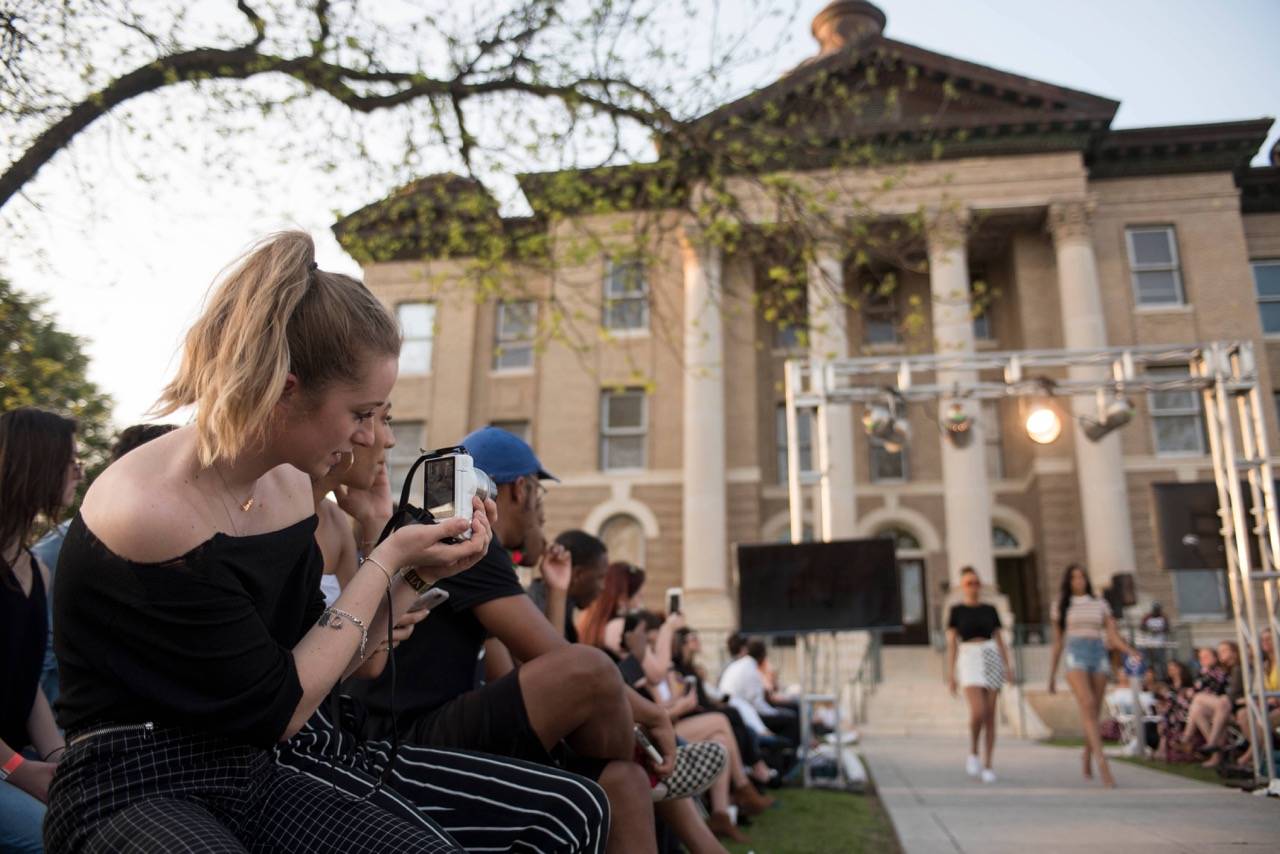Doom Scrolls: 1918 v 2020
Data Visualization Meets Grief

The 1918 Influenza Pandemic was a deadly event that towers over the 20th Century as a fatal twin of a world war. However, it has left barely a scar on our collective memory. When, as part of the 100th Anniversary of the end of WWI, public attention returned to 1918, it was with a searching light as historians sought to find evidence of the impact of this experience of death on a global scale in our culture (Robin, 2020). In March 2020, just a bit over a century later, another pandemic swept through the world. And, unlike the 1918 Influenza Pandemic, the information rich environment of the internet and social media meant that we were bathed in detail, in data. A new term was coined, “doom scrolling” to describe the hypnotic lure of a newsfeed, continually updated with charts, tables and maps showing the spread of the death (Fitzgerald, 2020). Cut off from the outside world they travel through the news of the day with it particular focus on the data about the pandemic. Unlike the 1918 pandemic where communities could recognize the human loss in missing neighbors but were not sharing the news in the form of data.
In many parts of the world, it was just over a year before an effective vaccine was made available to teachers and students and it was almost two years before schools and campuses began to unclench their careful hold on social contact. On the Texas State University campus, an undergraduate research group in the Fashion Merchandising program called ‘Sewing Circle’ was meeting in spring 2020 with Dr Gwendolyn Hustvedt, a Professor of Textiles in the Fashion Merchandising program. The purpose of their project to engage with historical artifacts from the Home Economics program at Texas State in 1915 and 1916 and to use hand sewing to produce recreations of artifacts such a sewing aprons and corset covers. Lockdown meant that the group members were isolated, and the focus shifted to sewing masks. Discussion about the 1918 Influenza Pandemic turned to examination of the historical sources being used for the project for evidence of the impact of the illness in our local community more than 100 years earlier, but there was almost no mention of death by influenza in the newspaper, in obituaries. The Red Cross Club was meeting in 1918 but was making bandages for the war effort or gathering supplies for European refugees. But then we uncovered, in the Alkek Special Collections, the 1917-1919 Pennington Funeral Home records and started counting the listing of funerals, with date of death and names and saw that we could chart the wave of influenza from October 1918 through January 1919. It is from this data, and the silence of both the 1918 Pandemic and the isolation of the COVID-19 Pandemic that this current piece was conceived and created by Dr Hustvedt as a personal memorial.
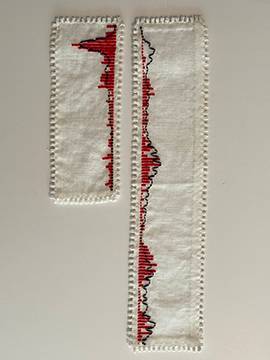
Doom Scrolls: 1918 v. 2020 is a visualization of death in a local community placed on the background of a shroud. There is a long tradition of ‘reading’ embroidered textiles for their meaning (Brodie, 2016; Damhorst, 1990). Made from entirely natural fibers, the scrolls are stitched in wool and linen on linen using yarn purchased from the Husflied (National Handicrafts Shops) in Oslo, Norway. The embroidery styles include cross and Holbein stitches taken from images of West Telemark artifacts (Norsk Institutt for Bunad og Folkedrakt, 2022) with a hemstitched Taggar border using the Hardanger style from Vestland (Stuland, 1960). The choice of Norwegian styles throughout was to reflect Dr Hustvedt’s ethnic heritage.
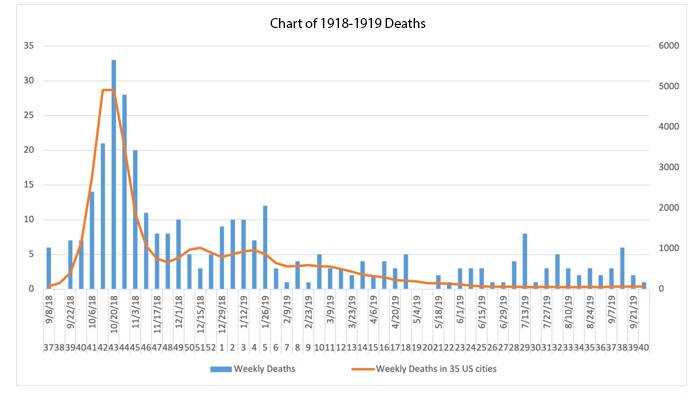
Each bar in the scroll represents a week, starting September 19, 1918 and March 3,2020, and each cross stitch in red represents a death in the community during the week for one year in 2018 and two years in 2020-2022. The Holbein stitches in blue and yellow are on a different scale to chart the thousands of deaths each week across the United States. While the data for the 2020-2022 scroll was taken from county public health records (local deaths) and CDC records (national deaths), there was no CDC in 1918 and so national deaths were taken from a research article by Collins et al. (1930) that counted weekly deaths from influenza and pneumonia in 35 US cities, the closest available approximation (see Figure 1). The 1918 scroll was stitched in mirror inversion to the 2020-2022 scroll to allow more direct comparison of the waves of each pandemic and are oriented in the vertical to evoke the smartphone screens that glowed their “doom scrolling” late into the night. Placing the doom scrolls over the heart of the figure which represents both death and the care provided by community to its dead is intended to speak to the deep wounding that the loss on the scale would create.
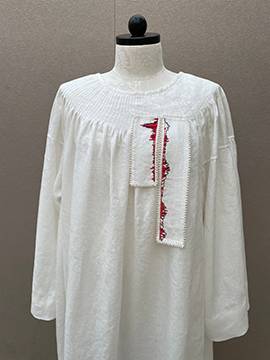
The shift, worn for millennia as an interior layer between expensive and precious exterior garments and the body, also represents the human figure. Textiles, especially garments, have an important place in the death and grieving process (Ayling-Smith. 2019). The type of garments worn in death vary widely from community to community (Davidson, 2016) and in the 20th century, a time of wealth and luxury, the choice of street rather than bed clothes also signifies our increased distance from the death bed. During the COVID-19 Pandemic, for many families this distance was entire, as their loved ones died in hospital isolation rather than in the comfort of their own bed and nightclothes.
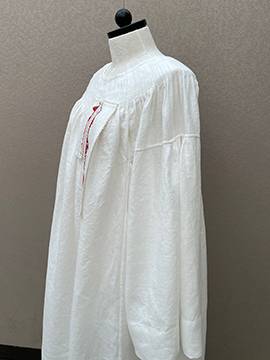
Stitched entirely by hand at home, the shift is intended to be worn as a shroud. Choosing the four yards of even weave linen, used for both the shroud and scrolls, selecting the silk thread for sewing and designing the shift based on historical artifacts was the start of an act of grounding and coping with the intense fear of death created by the pandemic experience of forced social isolation. The neckline of the shroud, echoing garments such as 19th century Norwegian shirts called skjorte (Norsk Institutt for Bunad og Folkedrakt, 2022), features 140 pleats, with stitches to match each of the 4,082 weeks of the typical American life span (in 2019) of 78.5 years. The flat felled seams and deep hems are intended to make the garment smooth and blank on the inside where it would touch the body. Ultimately, the shroud is the background, the bed, on which lies the full weight of past death. Just as each stitch in the scrolls represents a person whose body is already folded away from sight, leaving only a name on a ledger, the shroud recedes from the eye leaving only the red crosses, and 100 years from now, another pandemic in distant record.
References
- Ayling-Smith, B. (2019). Connecting with the viewer: affectivity and cathexis in textile artwork. Textile, 17(3), 296-311.
- Brodie, A. (2016). Marking and Memory: An Embroidered Sheet in the Collection of the Victoria and Albert Museum. Textile, 14(2), 160-175.
- Collins, S. D., Frost, W. H., Gover, M., & Sydenstricker, E. (1930). Mortality from influenza and pneumonia in 50 large cities of the United States, 1910-1929. Ann Arbor, Michigan: Michigan Publishing, University Library, University of Michigan.
- Damhorst, M.L. (1990) In Search of a Common Thread: Classification of Information Communicated Through Dress. Clothing and Textiles Research Journal, 8(2), 1-12.
- Davidson, H. (2016). Grave Emotions: Textiles and Clothing from Nineteenth-Century London Cemeteries. Textile, 14(2), 226-243.
- Fitzgerald, S. (2020, July 30). The Internet wants to keep you ‘doom-scrolling.’ Here’s how to break free. Washington Post. Retrieved from https://www.washingtonpost.com/lifestyle/wellness/coronavirus-doom-scrolling-stop/2020/07/29/2c87e9b2-d034-11ea-8d32-1ebf4e9d8e0d_story.html
- Norsk Institutt for Bunad og Folkedrakt. (n.d.). Digitaltmuseum. DigitaltMuseum. Retrieved May 15, 2022, from https://digitaltmuseum.no/owners/NBF
- Robin, W. (2020, May 6). The 1918 Pandemic’s Impact on Music? Surprisingly Little. New York Times. Retrieved from https://www.nytimes.com/2020/05/06/arts/music/1918-flu-pandemic-coronavirus-classical-music.html
- Stuland, G. (1960) Hardangersaum. Oslo, Norway: Fabritius & Sønners Forlag
